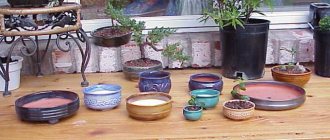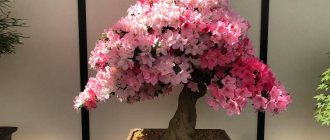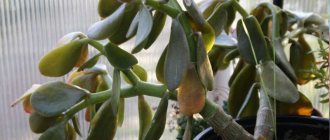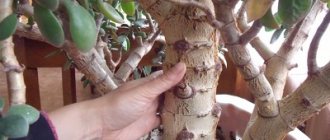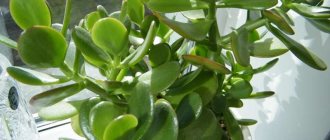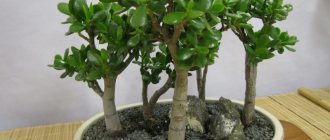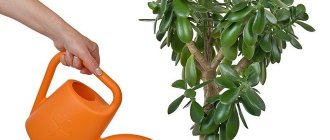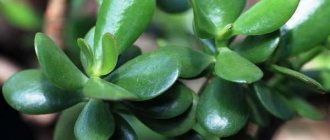How to grow a miniature tree with your own hands
Bonsai - DIY home care
Crassula usually grows large. To achieve this at home, you need to use the bonsai technique. You can not only get the required size of the plant, but also give it an original shape. The correct choice of container and planting technique play an important role in this.
Selection of capacity
To create a Crassula bonsai, you will need a suitable container. The pot should be wide and low. This will significantly limit the space for root development and the plant will not grow large. For the first time, you can plant it in a regular flowerpot. When the tree reaches the desired height, it can be transplanted into a wide container with drainage holes.
Landing
Most beginners do not know how to make a bonsai from a crassula. Step-by-step instructions will help with this:
Planting Crassula Bonsai
Remove the young tree from the flowerpot, removing excess soil near the root. The roots are shortened according to the size of the pot. It is necessary to remove rotten and too long roots. Bare and weak branches are removed with sharp scissors. The shoot is carefully placed in the container
The roots should be carefully straightened by hand and secured with support wire. The container is filled with soil; it is necessary to leave 1 cm at the edge of the container. Evenly distribute fertilizer on top, as well as small pebbles and moss. The pot with the fat plant must be watered until it flows into the pan. Place the tree in a well-lit place.
Important! Crassula prefers dry soil. Excess moisture will lead to rotting of the root system
Therefore, a thick layer of drainage is poured onto the bottom of the flowerpot; expanded clay, gravel, and vermiculite can be used.
Content Features
Why does an ornamental money tree at home turn into a sloppy, ugly plant with crooked, thin and long branches? Perhaps we are talking about a violation of the conditions of care and maintenance of this tropical inhabitant. Thus, thinning and elongation of succulent branches often occurs due to excessive watering and lack of light.
Overwatering can be called the most dangerous mistake a gardener makes, due to which succulent vegetation dies. Being in waterlogged soil, the rhizome of the succulent becomes infected with rot and dies, and excessive saturation of the trunk with moisture leads to disruption of its structure and further damage.
The correct selection of container is also important for the correct formation of the bush. If it grows in a shallow, wide pot, it produces a large number of lateral shoots and does not stretch upward.
Choosing a tree for bonsai
Fragrant myrtle bonsai. how to grow at home?
In order to grow a beautiful bonsai tree at home without much hassle, it is best to choose one of the plants listed below, about which gardeners have extremely positive reviews. The photos will help you see what such a green pet will look like.
- Indoor types of citrus fruits: orange, lemon, calamondin;
- Ficus benjamina;
- Dwarf pomegranate;
- Willow;
- Decorative varieties of apple trees;
- Barberry;
- Hawthorn;
- Oak;
- Maple.
These are just some of the most popular options. Growing bonsai can be done from a variety of plants that are found everywhere: in parks, forests, gardens. You can also purchase seedlings in nurseries. The price will depend on the type of tree chosen and its height.
Some ideas for using perennial succulents in the garden
Let's consider several interesting solutions for design combinations of plants:
- Succulents and stumps. An old stump or snag will serve as an excellent place to plant a succulent. The youngster will fit perfectly into such an exterior, it will look light and interesting.
By placing several stumps with such crops, you can complement the entrance area or a beautiful terrace. - Compositions in pots or flat vessels. Choose containers that match the style of your garden. For example, take a shell, garden sculpture or other interesting object and plant miniature garden-grade perennial succulents inside to create incredible beauty.
Such compositions can be installed on the loggia, next to the gazebo, and other places to create an incredible design. - Mosaic flower beds. In such flower beds, crops are planted in groups, always alternating different colors and varieties.
Photo of succulents in a flower bed in the garden This will allow you to create interesting patterns and ornaments.
Another original option for planting succulents in the garden is to plant them in small pots and then place them as decoration on a terrace or open loggia.
Succulent Information
What is Kokedama and how to create it
Best Ideas on How to Use Succulents in Interior Design
How to make compositions from succulents: a selection of the best ideas
Decorating the garden with “Stone roses”
Juvenile (Sempervivum) or “Stone Rose” is considered one of the most popular and recognizable plants in our latitudes. Even in France in the 19th century, culture was used to decorate various architectural elements. The plant has not lost its popularity even now. With the variety of color palettes of this amazing succulent, you can create colorful pictures in your flower beds.
Photo of succulents Stone roses in the garden
For example, if you need to effectively draw curves on a site, outline gazebos or paths, you can mix crops based on the shape and color of the leaves.
A mono-planting of crops will look impressive. This is a decorative option when only one variety is used, but in different variations. Compositions look very beautiful when barberry becomes the background and young rosettes are planted around it. To complete the composition, picturesque boulders are planted next to the crop, and the space around it is filled with fine crumbs.
How to plant succulents in a mini alpine garden
A mini alpine slide made of succulents in the garden is the most popular option for decorating an area where exotic crops are used. Making such a composition is not difficult if you use a few available tools and put in a little effort. We suggest considering the option of creating a miniature alpine slide from an old basin. So, for work you will need:
- metal basin;
- expanded clay or gravel to choose from;
- soil for garden crops;
- cement;
- stones, small crushed stone;
- decorative sand.
The beginning of the work is to create a decorative container. The cement is mixed and then crushed stone is added. An excellent solution would be to add regular peat and perlite instead of crushed stone and sand in a consistency of 1 part cement, 1.5 parts peat and 1.5 parts perlite (the so-called Hypertufa). The basin is turned upside down and covered with a layer of cement mortar (thickness from 2 to 5 centimeters).
Photo of a mini rock garden with succulents
If the bottom is too rusty with holes, you should not cement them, because this is an excellent solution for water drainage. If there are no holes, take a thick nail and make several holes. Leave the mold to dry for 24 hours. Additionally, you can scratch the surface, lay mosaics on it, attach household glass, remnants of tiles or shells. Here you can experiment. When the container is dry, the basin is pulled out and the hardened container is placed in a permanent place. If you wish, you can not create a concrete container but use the basin itself as a container.
Expanded clay or gravel is laid at the bottom to create a drainage layer. The soil is poured on top and lightly compacted, and several large stones are placed there to simulate a rocky landscape. The created composition is watered, you need to wait until the soil subsides and then add a little new one.
The next stage is to form compositions of succulents in a mini garden, carefully planting the crops in place. Various Crassulas, Agaves, and small varieties of cacti are suitable for an alpine hill. Their location inside the container depends on your imagination and skills.
Miniature garden of cacti and succulents
A mini garden in a pot made of succulent crops is also an original solution to complement the territory. To have a beautiful miniature garden, you must first choose the right pot. The main condition is the presence of holes in the container, which will allow residual liquid to drain after watering. The remaining selection parameters should be approached only from a creative side, based on your own preferences.
The materials for the products will be plastic, glass, and stone containers. Shades can be either different or neutral.
But when implementing interesting ideas for a garden with succulents in pots, remember the size of the root system. Since the roots are quite small, the containers do not need to be too deep. Also think about the pallet. The average height of the pallet is 1/3 of the total composition.
The next stage of preparation is the substrate. In the natural environment, crops prefer to grow on sand, sometimes with the addition of crushed stone. Therefore, at home, choose loose soil that allows water and air to pass through well.
Next we proceed to the creative process - the formation of the composition. The foreground is necessarily complemented by low-growing plants. At the border of the container you can place species that will hang down a little.
To design the background, use a technique that creates a sense of perspective. Flowers that are larger in size than others are planted there. For example, Crassula and Stapelia are suitable. You can supplement the container with sophisticated driftwood, branches, and figures that will create the effect of a miniature rock or slide.
Planting is very easy. A drainage layer is placed in the selected pots, after which soil is placed, and the top layer is necessarily sprinkled with water. The culture is placed at the selected point. A layer of pebbles or shells is placed on the surface, which adds decorativeness.
Vertical gardening with succulents
By using winter-hardy succulents in the garden, you will be able to create an area of incredible beauty. For such purposes, special vertically directed structures are used.
For example, it is relevant to use:
- trellises for trellises made of garden nets and frames;
- vertical flower beds made of wooden boxes;
- arches and tunnels based on meshes and reinforcement.
The phytomodule is popular . It is based on a frame into which containers for arranging succulent representatives are attached. This module allows you to create not only vertical flower beds, but also living pictures. To make your plans a reality, you should consider several important points:
- plants will need to be given direction;
- crops that grow too large need to be trimmed and overgrowth removed, which will violate the integrity of the image;
- crops will have to be fed, sprayed, illuminated, which will allow the leaves to look beautiful and healthy.
It is better to give preference to plants that maintain their shape without additional care. Ivy, Hoya, Sedum, and Raspberry are ideal for decoration.
Description of Crassula
5 Ways to Encourage Your Money Tree to Bloom
All representatives of the Crassula genus belong to succulents, that is, they have special tissues that can accumulate water. Different types differ:
- stem structure,
- leaf shape and color;
- length and structure of lateral branches.
Representatives of Crassula have similar features. They usually have thick leaves that come in a variety of colors.
Interesting fact. Crassula flowers bloom like all other plants. However, this usually occurs in natural conditions. Indoors, these plants rarely bloom.
Characteristics of the variety
For bonsai, different types of Crassula are chosen:
- Crassula ovate - has thick, green, almost round leaves. The trunk is well developed and branched;
- Helms - similar to Ovate Crassula, but the leaves are elongated;
- Ovata – branches abundantly. Has small oval foliage;
- The tricolor is very different from its counterparts. The leaves are green, with white stripes and red edges. They are located very densely, almost completely hiding the trunk;
- Minor - has small reddish leaves;
- Silver is a type of Crassula, which is popular due to the light specks on the leaf blade.
All of the listed species produce a lush crown, from which you can form a bonsai of the correct shape.
Important. Although the leaves and stems of Crassula look soft and fleshy, they are not eaten
Poisonous arsenic accumulates in them.
Why is the plant called the money tree?
Crassulas are trees with a woody stem and a branched crown. There are several options for the appearance of the prefix “money” in a plant:
- the leaves of some types of crops are shaped like a coin;
- It is believed that plants bring money into the house;
- unpretentious Crassulas are able to thrive even in very poor soils with a minimum of water. Therefore, they can serve as an example of hard work and motivate to achieve goals.
Whether to believe in omens and legends is something everyone decides for themselves. Many people love Crassulas and grow them at home because of the very unusual appearance of their foliage and crown.
How to grow a miniature Crassula tree with your own hands?
When working with an adult Crassula, you will have to subordinate your ideas to the original size of the plant. By growing a tree from a sprout, you can form the most interesting forms of bonsai.
But in the latter case, you will have to wait until the Crassula stem becomes woody.
Selection of pot and soil
To plant the fat plant, choose a heavy ceramic pot. Its porous material will ensure uniform drying of the entire earthen clod, and not just its upper part. And the heaviness will help maintain the stability of the tree, the large crown of which is much heavier than the small root system.
In plastic, the fat plant grows much worse and sometimes turns over. Crassula is planted in a soil mixture for succulents, which provides water permeability and air access to the roots of the plant.
You can make the soil for the fatty grass yourself. To do this, take the following components in a 3:1:1 ratio: turf soil, rotted leaves and sand or other baking powder. You can add a little brick chips and crushed charcoal to the prepared soil to protect it from rotting.
Landing
The best soil for Crassula is soil for cacti or succulents. The soil mixture should be loose. Light soil perfectly allows air to pass through, which is important for the full development of the root mass.
To prevent the soil from being washed out of the dishes, you need to cut off several pieces of cellular vinyl mesh, square or rectangular in shape. Size – larger than the bottom of the container. The mesh cells should be smaller than the drainage hole.
Prepare copper wire (7 cm) and make a loop along the edges. Thread the resulting curves into the drainage hole, securing the mesh. In a similar way, attach a piece of wire to the bottom of the container to secure the succulent.
Further progress:
- Prepare Crassula. Clear its root system from the soil.
- Gently untangle the roots and straighten. For convenience, it is recommended to use a crochet hook.
- Trim the roots of the fat plant so that they fit into the selected container.
- Cut off dead areas and those that grow downwards.
- Cut off bare and weak branches of the money tree.
- Use pruning shears with a concave blade to cut off opposite branches.
Pour a small amount of soil into the pot. Place the succulent in a bowl, carefully distributing the root system. Pour the rest of the soil into the container and water it with settled water.
This video shows root pruning and replanting a money tree.
Where to start forming a tree?
Selection of pot
The diameter of the pot for the fat plant is selected according to the size of the crown: slightly larger than its diameter. As the plant grows, the width of the container needs to be increased. A tree with a voluminous, fleshy crown will become more stable. Ideally, a money tree pot should be wide, heavy and flat. A drainage layer is laid out at the bottom.
Not every pot is suitable for a fat plant. Its root grows close to the soil surface. Therefore, a shallow pot for rooting is suitable. The tap root of a crassula in a deep pot tends downward, and the stem tends upward, while thinning and weakening.
The soil
The soil for Crassula is light, loose, and porous. The money tree does not like fertilized and fertile soil. The substrate for Crassula should include humus, sand, leaf and turf soil.
Home care
When forming the crown and growing Crassula, much attention is paid to location and lighting. Crassula prefers bright light, but direct sunlight will cause the leaves of the flower to turn red. If there is not enough light, the stem will stretch, the branches will bend, and the crown will lose its symmetry. For this reason, it is recommended to rotate the flower periodically. At the same time, do not forget about the fragility of the branches.
Careless handling of the plant will lead to breaking off of the fleshy, heavy branches.
The tree-like fatty plant does not need frequent and abundant watering. Thick and fleshy leaves of the flower are able to accumulate moisture
Crassula is one of those plants that is better to underwater than overwater. It is more demanding when it comes to wiping leaves and general spraying. Clean leaves are saturated with oxygen and become elastic.
When grown in an apartment, Crassulas branch weakly and grow long and thin. Therefore, the crown and trunk of the money tree are formed.
You will find more information about the rules for caring for a fat woman here.
Methods for pruning a plant
There are several different schemes, the appropriate one is selected based on what shape of the crown the grower wants to get:
A tree with a powerful central trunk
To strengthen this part of the succulent, the young fat plant should be trimmed, removing not only the branching shoots, but also the lower foliage. If you need to strengthen the central trunk of an aged tree, then you need to trim all the shoots and be sure to fertilize it.
It is better to plan the procedure in the spring, before the plant enters a period of active growth. At the end of autumn, it is recommended to pinch out the upper part of the shoots.
Crassula, which has a thick central trunk and a crown of hanging apical shoots
Such formation is possible only if measures have previously been taken to strengthen the trunk of the Crassula. Otherwise, the thin trunk may not withstand the load and break under the weight of branches and foliage.
That is, you should initially pay attention to pruning, thanks to which the trunk becomes large and powerful, and only then leave shoots in the upper part of the succulent
Formation of a compact, low bush
To prevent the flower from stretching out, but turning into a lush, voluminous bush, it is rarely watered and the foliage on the trunk is regularly removed.
Spreading shrub
Forming the crown of a money tree using this type of process is not complicated. To do this, it is necessary to pinch the shoots growing from the apical buds so that the shoots branch from the axils located below the cut.
Some gardeners plant several succulents in one container and then a luxurious bush is formed from their shoots. However, this method is considered inappropriate, since the plants grow and begin to oppress each other, suffering from lack of space and nutrition; their development slows down over time and may stop altogether.
The formation of the crown is affected not only by pruning or lack thereof, but also by the conditions in which the flower is kept.
How to trim step by step?
This procedure is usually carried out in the spring.
Progress:
- Full pruning of branches is done above the brown rings (leaf scars) that are located around the stem.
- The cut should be straight. If after pruning there are depressions and scars left, they will cause the succulent to rot.
- When cutting a 6–9 cm branch, leave one or three pairs of leaves at the tips of the stems (this depends on their location in the crown).
- There is no need to trim all the branches in one go. It is better to take weekly breaks so that the fat woman can rest.
To control the density and shape of leaf buds, it is recommended to lightly pinch the Crassula, approximately 1–2 times every 7 days. You should pinch off overly large leaves, as well as leaf buds growing in the lower zone of the succulent.
Weekly pinching (pinching) of the branches will stimulate the development of the remaining buds. The leaves that emerge from them will be miniature. The growing succulent will become more and more like a dwarf tree.
Wire wrapping
Long branches need to be trained to the chosen direction. For this purpose, it is recommended to use copper wire. It should be soft. Carefully bend the copper to form the intended shape of the crown. After 3 weeks the result will be noticeable.
Next, secure the crassula with support wire. Fill the container with soil mixture, leaving 1.25 cm between the edge of the container and the ground. Sprinkle the soil surface with granular fertilizer.
On a note!
Don't worry if there are wire marks on the branches. Once the water saturates the wood, the dents will disappear.
This video shows how to make a money tree bonsai using wire.
Possible difficulties and common mistakes
To avoid difficulties when growing money tree bonsai , you must follow the following recommendations:
- cuts should not be covered, as this will provoke the development of putrefactive processes. It is better to dip the cut into charcoal powder;
- When watering the ground, you need to make sure that water does not get on the leaves of the money tree ;
- If there is a need to replant the succulent, then do it every few years. It is recommended to replant a young succulent no more than once every 2 years, an adult plant - once every 3-5 years.
- When replanting a money tree, you should inspect the root mass . Soft or dark roots should be cut off and the soil replaced.
Carefully!
Frequent repotting can have a negative impact on the succulent, slowing down its growth.
Using the above tips, you can form a real bonsai from Crassula; this miniature tree will become an exotic decoration for the room .
Video: Money tree. Crown formation. Pruning Money Tree Branches
If you need to make the Crassula trunk thicker and the crown thicker, trim and pinch the tips of the shoots. If a branch has grown too long, don't be afraid to trim it. Make a cut 2.5cm below where you want new leaves to grow. Regular pruning of branches releases excess energy to the trunk, and it gradually thickens.
Is it possible to prune the fat plant? How to trim the branches of a money tree so that it grows into a stem? Prune the crassula just above one of the brown rings around the stem, called a leaf scar, with sharp pruning shears or a knife. New shoots will grow at the site of the cut, so choose the stem you want to cut carefully.
Your choice will depend on where you want the trunk to be thicker and the foliage to be denser. This method is good for old plants that have heavily developed stems and little foliage.
Cut bulky branches with pruning shears or small, sharp-edged scissors to achieve the desired tree shape. Do this in stages if necessary, giving the plant a chance to rest between trimmings. This way you can better imagine the shape of the crown.
Remove large leaves to allow light to reach the inner parts of the canopy where you want new leaves to grow. The cuts should be neat and straight. Pits and scars can cause rot.
Lightly trim once or twice a week to keep leaf bud size and density under control. Pinch off overly large leaves or leaf buds growing in undesirable places, such as the bottom of the trunk. Use long tweezers to remove cut parts.
Do not use garden varnish. Instead, let the cut pieces dry and form a film. Pathogenic bacteria can penetrate the garden varnish and cause rotting. Sterilize tool blades with alcohol after each pruning to prevent disease, especially if you are working with multiple plants.
Pinch the tip of the stem with your thumb and forefinger to remove it. Decide how you want the fat plant to look in the future so you can choose the right site. Two new stems will appear at the pinching site. This method is good for young plants or short stems if you want a thicker crown.
Place the Crassula in a sunny location, preferably a south-facing window, where it will receive at least four hours of sunlight each day. The daytime temperature should be between 18 and 23 degrees during the day and between 10 and 13 degrees at night. Protect from drafts. Leaves should not touch the glass or window frame. If you provide the plant with these conditions, its crown will be dense.
Plant Crassula in well-draining soil in a pot with drainage holes. Replant every few years if necessary. If possible, do not replant at all. Concerns such as replanting can slow down growth.
Water the plant often enough in spring and summer to keep the soil moist but not soggy. In winter, let it dry out between waterings. Water the soil and do not let water get on the leaves of the plant. Providing proper, regular watering helps the trunk and branches thicken naturally.
Fertilize every three or four months with liquid fertilizer and the crown will become dense.
Further care
It is better to keep Crassula in a well-lit place with little shade. The ideal solution is the south side of the apartment. Here the plant will receive enough sunlight .
The daytime temperature should be 19–23°C, the night temperature should be 9 and 15. In winter, the Crassula tolerates dry indoor air without any problems.
Care requirements:
- you should beware of drafts;
- the leaves should not come into contact with the window frame or glass ;
- In order for the fat woman to avoid deformation, it must be turned regularly;
- Fertilize the plant after 3.5 months with a special liquid solution, which can be purchased at a flower shop.
In the spring and summer, Crassula needs careful watering . In winter, you should wait until the soil dries out. Proper, regular watering will help the trunk and branches thicken naturally.
Remember!
If the succulent is provided with the necessary conditions, its crown will become powerful and beautiful.
How to grow crassula yourself?
The easiest way to propagate Crassula is by cuttings. You can use parts cut from an adult plant when forming the crown:
- The cuttings are placed in water, removing the leaves from the bottom (rooting stimulants can be added).
- Periodically check the freshness of the water and add new water if necessary.
- After a week, the Crassula is ready for transplantation.
If you have a lot of cut branches of different lengths, but you want to get one or two plants, you can use an easier method:
- Select straight cuttings.
- Plant them in a bowl filled with moist potting soil.
- Water the soil periodically.
- After a few weeks, when the shoots take root, select the strongest ones and transplant them into a pot.
Soil selection
Crassula is not a demanding plant. To plant it, you can use any universal substrate. Under natural conditions, succulents “manage” to grow even on brackish soils, in regions with low rainfall. They do not like acidic soils.
For Crassula, you can buy any universal soil mixture (soil) or make it yourself:
- Take turf soil (3 parts) and deciduous soil (1 part).
- Add some humus.
- If the soil is heavy and clayey, then you need to add coarse sand.
- Stir the mixture to form a homogeneous soil.
Planting step by step
Before planting or transplanting, the roots are inspected and rotten parts are removed. Excess and bare branches are cut off. When the fat plant is ready for planting, do the following:
- Place the plant in the prepared pot. It should have drainage, sprinkled with soil up to approximately half the container.
- Place the shoot in a pot and secure it with a support wire (you can ask someone to hold the seedling vertically).
- The remaining soil is poured around the stem until 2-2.5 cm remains from the edge of the pot.
- Water generously until water appears in the pan.
- If the soil settles, you need to add a little to the desired level.
After planting, the plant is placed in its designated place.
How to make fertilizing?
The first two to three months after transplantation do not feed. Then you can use any complex fertilizers for succulents or universal fertilizers for the growing season. They are applied one or two days after watering, preferably in the afternoon.
How to fertilize correctly:
- The fertilizer is diluted according to the instructions in rain, boiled or settled water.
- Water the soil until water appears in the pan.
- Excess liquid is drained, otherwise it will begin to rise, which will lead to excessive salinization of the soil. Although the fat plant tolerates high salt content in the soil, even such an unpretentious plant may not survive too high doses. You will have to wash the soil.
In summer, fertilizers are applied once a month. In winter - once or twice a season.
Crassula requires minimal care. You can forget about it for several weeks. The plant will react to lack of care with several yellowed leaves. When leaving, the main thing is not to harm:
- place the pot in a well-lit place. In order for the branches to grow in different directions, it needs to be rotated 2-3 cm every week. Otherwise, new shoots will reach towards the window. This is not so bad if you form a bonsai in an inclined or cascading shape
- provide moderate watering as the soil dries out. It is impossible for moisture to constantly stagnate in the pot. If you pour water once, the fat woman will survive it. But constant dampness will cause the roots to rot;
- in winter, the plant is moved to a cool place. If this is not possible, you need to ensure that the soil does not dry out. Otherwise, the leaves will begin to turn yellow and fall off.
To prevent the crown from becoming overgrown, it must be trimmed regularly.
Diseases and pests
Crassulas rarely get sick. But sometimes they are affected by insects or infections:
- the appearance of yellow and brown spots on the leaves is a signal of scale insect infection. You need to carefully examine the stems and leaf blades. If there are small (up to 2 cm) dense insects on them, more like dots, then immediate treatment is needed;
- Spider mites are another pest that can settle on Crassula. Insect infestation can be identified by the appearance of yellow spots on the leaves and the spread of cobwebs;
- cotton wool-like coatings on leaves and stems indicate mealybugs.
Insects are destroyed with insecticides. This is the most reliable way to get rid of pests. Since Crassula is not suitable for food, you don’t have to worry too much about environmental cleanliness.
Bacteria and infections rarely affect flora from other regions. In addition to insects, the fat plant is usually only threatened by too much watering. It leads to rotting of the roots. In this case, the plant is dug up. Then the rotten parts are removed and the Crassula is planted in clean soil.
Home care
Caring for a fat woman is not difficult. Essentially, caring for a money tree includes moderate watering, periodic feeding, removing dust from the leaves, pruning and shaping the crown.
Lighting
The shape of the fat plant can change depending on the intensity of light: with a lack of light, the trunks stretch out and become thin; with too much light, on the contrary, they thicken.
Crassula, or money tree, should be placed in places with sufficient lighting, optimally on the southeast side. This rule is recommended not only by flower growers, but also by Feng Shui experts.
It is important to ensure that direct sunlight does not fall on the flower, which causes the plant’s foliage to turn red, wither and fall. In summer, the tree crassula feels good and comfortable on the balcony, and in the cold season it is better to move the plant to windows facing south
Popular articles Everything you wanted to know about tulips
Watering
How often to water depends on the temperature. You need to water the money tree:
- twice a week - in hot weather;
- once every 7 days – at normal temperature;
- once every 20–30 days – in winter.
The person caring for the plant must ensure that the soil is not excessively wet, but also does not dry out. It is better to water the plant in the evening, with warm, settled water.
Humidity
Crassula tolerates moisture deficit well and does not require regular spraying. Dust accumulated on the surface of the sheet plates can be removed with a damp cloth. Crassula responds well to warm showers, which are carried out once every 2-3 months, covering the ground with film.
Temperature
In spring and summer, the optimal temperature for the plant is from 20 to 25 ° C; it is advisable for the flower to be on the balcony or street - a living tree does not tolerate a lack of fresh air. In winter, the plant is comfortable at a temperature of about 15 ° C or lower, but not less than 4 ° C.
At room temperature, the flower can also overwinter, but its leaves will most likely begin to wither and fall off. It is better not to place the money tree flower near heating radiators.
How to replant a money tree
You can learn how to replant a money tree from experienced gardeners. Transplantation is carried out once every 2-3 years, not more often, and only if necessary - if the flower has grown greatly.
To maintain compact dimensions, you can do without replanting and only replace the top layer of soil in the pot.
The plant is transplanted in the spring (preferably in May) into a pot slightly larger than the previous one. The soil for replanting Crassula is taken from ordinary purchased soil, intended for planting cacti and succulents.
You can prepare such a soil substrate yourself by mixing part turf soil and sand with three parts leaf soil. If you add a handful of humus, clay, ash to the ground, the nutritional value of the soil will increase
In order for the transplanted flower to grow well, it is important not to forget about drainage - expanded clay or crushed shards
The roots of the plant along with a lump of earth are placed in a pot filled with drainage material and a quarter of soil. Then the voids are filled with new soil substrate. After transplanting, the flower is watered well. The soil is periodically loosened to improve oxygen supply to the roots, and if the soil sags, the top layer is added to the pot.
How to trim Crassula
To create a beautiful decorative look, you need to trim the money tree. The formation of the flower crown begins while the tree is still young. When the height of the fat plant reaches 15–20 cm, pinch off the two small top leaves. As a result, branching will begin in this place, and four leaves will appear instead of two. As Crassula grows, the top leaves are removed in places where shoots are expected to branch.
Is it possible to trim the stems and leaves of an adult plant? It is possible, but in this case, stumps remain in place of the truncated shoots, spoiling the appearance of the Crassula.
How to grow a miniature tree with your own hands
Bonsai - DIY home care
Crassula usually grows large. To achieve this at home, you need to use the bonsai technique. You can not only get the required size of the plant, but also give it an original shape. The correct choice of container and planting technique play an important role in this.
Selection of capacity
To create a Crassula bonsai, you will need a suitable container. The pot should be wide and low. This will significantly limit the space for root development and the plant will not grow large. For the first time, you can plant it in a regular flowerpot. When the tree reaches the desired height, it can be transplanted into a wide container with drainage holes.
Landing
Most beginners do not know how to make a bonsai from a crassula. Step-by-step instructions will help with this:
Planting Crassula Bonsai
Remove the young tree from the flowerpot, removing excess soil near the root. The roots are shortened according to the size of the pot. It is necessary to remove rotten and too long roots. Bare and weak branches are removed with sharp scissors. The shoot is carefully placed in the container
The roots should be carefully straightened by hand and secured with support wire. The container is filled with soil; it is necessary to leave 1 cm at the edge of the container. Evenly distribute fertilizer on top, as well as small pebbles and moss. The pot with the fat plant must be watered until it flows into the pan. Place the tree in a well-lit place.
Important! Crassula prefers dry soil. Excess moisture will lead to rotting of the root system
Therefore, a thick layer of drainage is poured onto the bottom of the flowerpot; expanded clay, gravel, and vermiculite can be used.
What it is?
Bonsai is the art of gardening that involves growing a real tree in miniature. In this case, the above-ground part of the plant corresponds to the size of the root system and the proportions of this tree in nature.
The main task when forming a bonsai is to make the tree small. This is achieved in the following ways:
- Slow growth by:
- Root cuttings.
- Removing young shoots.
- Selecting poor soils with minimal use of fertilizers.
- Using special flat pots that prevent root growth.
Using the method of weakening the flow of juices. Transverse cuts are made on the trunk or the trunk is braided with wire.- Branch cuttings. Pruning helps awaken the necessary buds.
- Bending of branches. The branches are entangled with copper wire.
Growing bonsai requires patience, attention and time. You can speed up the moment of obtaining this miracle by using various types of Crassula for bonsai.
Types of bonsai for home for beginners
To begin with, we must choose those bonsai that tolerate being in our dark houses or apartments quite well, forgive mistakes in care, respond well to pruning, and quickly develop new shoots.
Large-leaved podocarp (straginaceae)
A tree that is probably one of the few conifers that will do well in our apartments in winter. However, it is worth remembering to provide them with good lighting.
Ficus retusa (microcarpa) / Ficus benjamina
Small-leaved ficus is a good suggestion for beginner bonsai lovers.
It has many practical advantages:
- can be stored at room temperature in the apartment in winter;
- In summer, by planting a tree outside, we will get lush growth and small leaves;
- forgives a lot when it comes to care mistakes;
- Tolerates low lighting conditions quite well (although in winter, of course, it is better to light it);
- withstands cutting very well.
Bodhi tree (Ficus religiosa)
Did you know that Ficus religiosa was the tree under which Buddha received enlightenment? Bodhi is a tough plant that grows quickly and forms aerial roots. It has attractive shiny heart-shaped foliage that appears in a bronze color that later turns to a glossy green.
Baobab
A tall, gigantic and iconic African tree, the great baobab truly adapts to become a bonsai. Easy to care for and maintain in warm climates, baobab tree bonsai require some care during the winter in cooler zones.
Common beech (Fagus sylvatica)
This tall, majestic tree makes a large to medium sized bonsai specimen and is best presented in an upright plant style. Young shoots form easily, and in autumn the leaves turn golden yellow. Keep in mind that the beech tree is slow growing and takes time.
Pomegranate
The pomegranate is one of the most beautiful fruit trees and the easiest to grow into a bonsai. Because it has a shallow root system, it adapts well to bonsai culture. This robust plant looks great with attractive bark, stunning red flowers and gorgeous fruit.
Adenium
The thick bulbous trunk, vibrant flowers and glossy foliage make Adenium an ideal bonsai tree. This flowering tree creates a quick and natural bonsai look with minimal effort. A sunny place, protected from the wind, is required. If growing in a non-tropical climate, bring the tree inside in winter.
Scheffler's gnome
Schefflera arboricola is one of the most popular indoor bonsai trees. It is easy to grow, drought tolerant and hard to kill, making it an ideal bonsai for beginners.
Crepe Myrtle
Crape myrtle is one of the best trees for bonsai. Its main features are its exquisite branching, showy flowers in pink, white or purple, and what's more, it has outer layers of bark oozing out from time to time and the color of the main bark can vary from gray, rusty brown to almost pink.
How to trim step by step?
- Pruning should be done during the period of active plant growth.
- Before pruning, clearly determine the shape of the future bonsai tree.
- Outline the stems that will eventually form into bonsai branches.
- Make cuts strictly along the stem, without indentations.
- Leave the leaves at the ends, remove the remaining ones.
- Trim regularly 2 - 3 cm below the location of the intended leaves.
- Repeated pruning promotes a denser arrangement of the buds. Gradually, the fat woman will begin to turn into a tree.
- After pruning, leave the tree to dry. To grow Crassula bonsai, it is advisable to do light pruning weekly.
- In addition to pruning, the tree needs to be inspected and excess leaves (at the bottom of the trunk, uneven or too large) removed.
- Pruning is done in stages. Do not cut off all the excess shoots at once. This will give the plant a chance to rest.
How to form a crown
When pruning a tree and shaping the crown, it is important to keep in mind the intended shape of the tree. To make your bonsai original and attractive, it is important to decide which branches will develop
It is necessary to start decorating the crown when 6-8 leaves are formed on the branches. Usually they begin to form the crown of a bonsai in the spring, for this they do the following:
- completely cut off the branches above the brown rings, they are located around the stem;
- the cut is made straight, and if scars and indentations remain after pruning, then because of them the fat plant may begin to rot;
- if a branch 6-10 centimeters long is cut, it is necessary to leave one or three pairs of leaves on its edge, depending on its location on the tree;
- You should not cut many branches at one time. It is advisable to take short breaks, about 1 week, so that the tree has time to rest.
To control the shape and density of leaf buds, experts recommend pinching once or twice a week. Leaf blades that are too large are pinched off and those leaf buds that grow in the lower part of the trunk are removed. Thanks to weekly pinching, the remaining buds will develop more intensively, and the leaves emerging from these buds will be tiny. As a result, the tree will become increasingly miniature.
When does a plant need to be replanted?
If the bonsai grows in open ground, it does not need to be replanted, but in a limited volume, replanting is necessary so that the roots do not intertwine. This procedure is considered planned, that is, it occurs regularly at a scheduled time and depends on the age, size of the tree and pot, as well as the type of plant and nutrient soil.
For your information! Young plants, no older than 4 years, are replanted every spring, when the growing season begins, adult plants - once every 10 years. The signal for replanting is roots sticking out of the drainage hole and leaves starting to fall off.
There is another type of transplantation - emergency, it is carried out when the plant is sick or the roots have rotted.
Ammania - bonsai in an aquarium
Ammania, or rotala indica, is a plant with green leaves with pink tips. The aquarium serves as a pot for bonsai - a mix of breeding indoor fish and house plants. Both a regular and a nano aquarium are suitable for cultivation. Ammania bonsai often looks like a thick carpet and is a favorite plant for aquarium design.
Conditions and care for ammania
Ammania is a fragile plant that is not recommended for planting in an aquarium with large fish, otherwise they may damage the bonsai. How to accelerate growth? The solution is to supply more carbon dioxide.
Bottom substrate
Sand of a fine and light fraction of no more than 3 mm with a nutritious substrate, which is ideally fertilized with iron, is suitable as soil for ammania. You can take ready-made nutrient soil for bonsai. Ammania will bloom singly in four tiny cups.
Water temperature, hardness and lighting
The annual plant is adapted to the usual parameters of fresh water, where the pH is 6.0-7.5 and the hardness is from 3 to 8. The ideal water temperature is no more than 28 °C, but not lower than 22 °C. For normal growth, it is necessary to organize lighting with a full spectrum, and with weak light the stem and leaves will stretch. The bonsai shoot needs to be provided with strong light of 1 V per 1 liter of water.
Ammania cuttings
Ammania bonsai is not grown with seeds due to special growing conditions, so it requires special care and propagation. Further growth depends on proper cuttings, so it is necessary to pinch off the fleshy main trunk of the plant with narrow leaves located on it
By carefully cutting the cutting and placing it in the substrate, roots will appear on it, after which you can plant it in the prepared soil. Planting occurs with compaction into the substrate, but without pressing down the roots
Ammania cuttings
Growing living decorations is a fascinating, but difficult activity. Sometimes it takes several years
That is why, in the first couple of years, it is important to decide on the type of plant and the features of its care, so as not to suddenly ruin many years of work with incorrect actions
What types of Crassula are suitable?
To form a beautiful tree in the Japanese style, you need to choose the types of Crassula that correspond to such processing. Types of plants suitable for money tree bonsai:
- Crassula ovata is a bush with good branching. The branches are topped with juicy small oval-shaped leaves.
- Crassula hobbit - has oval-shaped leaves, fused from the base to the very middle. At the same time, they are turned outward.
Crassula bonsai
- Crassula tricolor - differs in the color of the leaves. The plates are painted green with white stripes along them. The leaves have a red edge.
- Silver Crassula - the leaves are covered with silvery dots that create a silvering effect.
- Crassula minor is a small plant with leaves that have a red tint. The length of the plates is about 1.5 cm.
Suitable species

